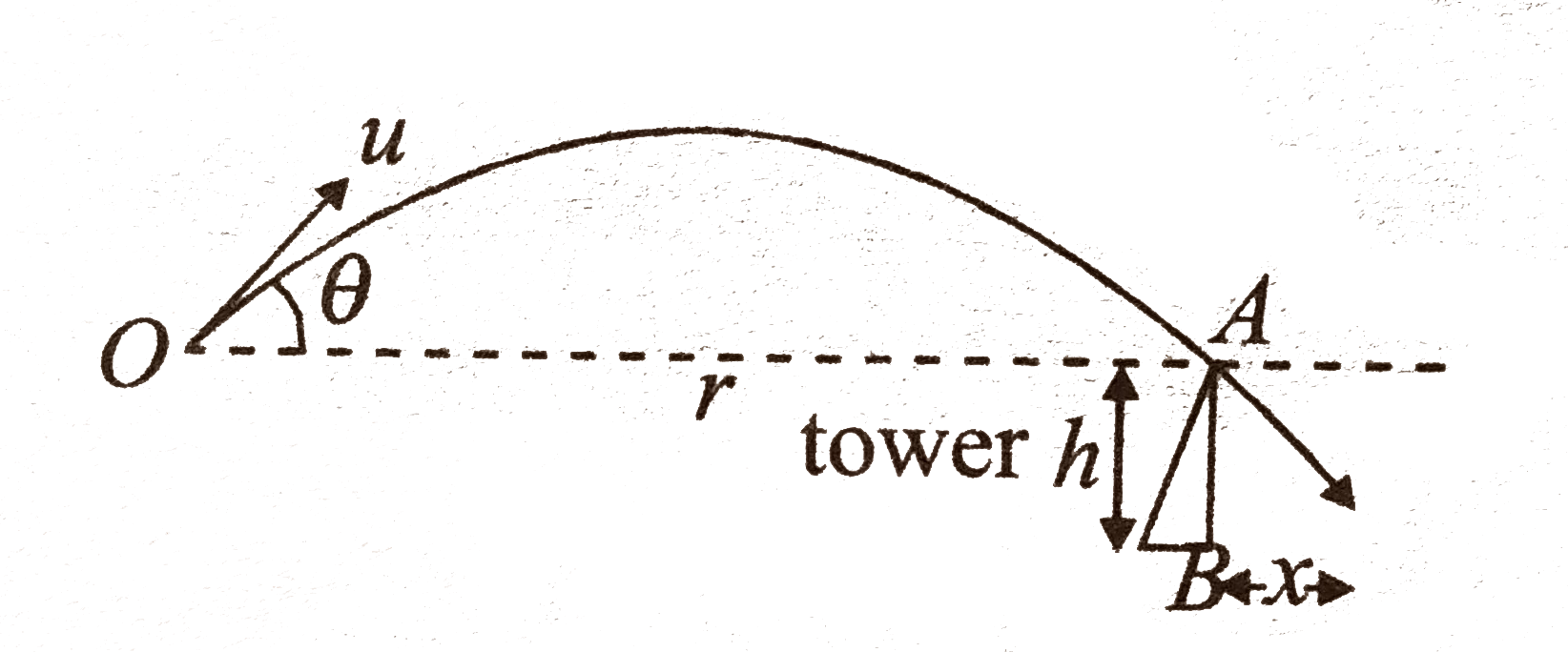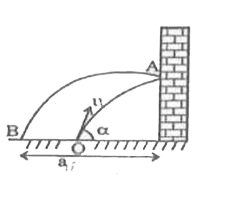A ball is thrown with the velocity u at an angle of α to the horizon. Find (i) the height of which the ball will rise to (ii) the distance x from the point of projection to the point where it reaches to the ground and (iii) the time during which the ball will be in motion (neglect the air resistance ).
To solve the problem of a ball thrown with an initial velocity u at an angle α to the horizontal, we will break it down into three parts: finding the maximum height, the horizontal distance traveled (range), and the total time of flight.
Step 1: Finding the Maximum Height (H)
The vertical component of the initial velocity u can be calculated using the sine function:
uy=usin(α)
The maximum height H can be found using the formula:
H=u2y2g
where g is the acceleration due to gravity (approximately 9.81m/s2).
Substituting uy:
H=(usin(α))22g
Step 2: Finding the Horizontal Distance (Range, R)
The horizontal component of the initial velocity u can be calculated using the cosine function:
ux=ucos(α)
The time of flight T can be determined from the vertical motion. Since the ball returns to the same vertical level from which it was thrown, we can use the formula:
T=2uyg=2(usin(α))g
Now, the horizontal distance (range) R can be calculated as:
R=ux⋅T
Substituting ux and T:
R=(ucos(α))⋅(2(usin(α))g)
R=2u2sin(α)cos(α)g
Using the identity sin(2α)=2sin(α)cos(α):
R=u2sin(2α)g
Step 3: Finding the Time of Flight (T)
We already derived the time of flight in Step 2:
T=2usin(α)g
Summary of Results
1. Maximum Height H:
H=(usin(α))22g
2. Horizontal Distance (Range) R:
R=u2sin(2α)g
3. Total Time of Flight T:
T=2usin(α)g
uy=usin(α)
H=u2y2g
where g is the acceleration due to gravity (approximately 9.81m/s2).
H=(usin(α))22g
ux=ucos(α)
T=2uyg=2(usin(α))g
R=ux⋅T
Substituting ux and T:
R=(ucos(α))⋅(2(usin(α))g)
R=2u2sin(α)cos(α)g
R=u2sin(2α)g
T=2usin(α)g
H=(usin(α))22g
R=u2sin(2α)g
T=2usin(α)g
Topper's Solved these Questions
- MOTION IN A PLANEBook:AAKASH SERIESChapter:MOTION IN A PLANEExercise:NUMERICAL EXERCISE (LEVEL -2)
Explore 19 Videos
- MOTION IN A PLANEBook:AAKASH SERIESChapter:MOTION IN A PLANEExercise:QUESTION FOR DESCRIPTIVE ANSWER
Explore 7 Videos
- MOTION IN A PLANEBook:AAKASH SERIESChapter:MOTION IN A PLANEExercise:VERY SHORT ANSWER TYPE QUESTIONS
Explore 10 Videos
- MOTION IN A PLANEBook:AAKASH SERIESChapter:MOTION IN A PLANEExercise:EXERCISE-3 (Circular Motion)
Explore 7 Videos
- MOTION IN A STRAIGHT LINE Book:AAKASH SERIESChapter:MOTION IN A STRAIGHT LINE Exercise:very Short answer type question
Explore 15 Videos
Similar Questions
A boy throws a ball with a velocity of 15 m/s at an angle of 15° with the horizontal. The distance at which the ball strikes the ground is
View SolutionA stone is thrown horizontally with velocity g ms−1 from the top of a tower of height g metre. The velocity with which it hits the ground is (in ms−1)
View SolutionFrom the the top of a tower 19.6 m high, a ball is thrown horizontally. If the line joining the point of projection to the point where it hits the ground makes an angle of 45∘ with the horizontal, then the initial velocity of the ball is:-
View SolutionA body is thrown with the velocity u=12.0ms−1 at an angle of α=45∘ to the horizon. If it touches the ground at the distance s from the point where it was thrown. From what height h should stone be thrown in a horizontal direction with the same initial velocity u so that it falls at the same spot ?
View SolutionA ball is projected horizontally from the top of a building 19.6 m high. If the line joining the point of projection to the point where it hits the ground makes an angle of 45∘ to the horizontal, the initial velocity of the ball is
View SolutionA ball is throw from the top of a tower of 61 m high with a velocity 24.4ms−1 at an elevation of 30∘ above the horizon. What is the distance from the foot of the tower to the point where the ball hits the ground ?
View SolutionA ball is projected from the ground with speed u at an angle α with horizontal. It collides with a wall at a distance a from the point of projection and returns to its original position. Find the coefficient of restitution between the ball and the wall.
View SolutionA ball of mass m is projected from the ground with an initial velocity u making an angle of θ with the vertical. What is the change in velocity between the point of projection and the highest point ?
View SolutionA ball is thrown from a point in level with velocity u and at a horizontal distance r from the top os a tower of height h.
At what horizontal distance x from the foot of the tower does the ball hit the ground ?
View SolutionA ball is projected from the ground with speed u at an angle α with horizontal. It collides with a wall at some distance from the point of projection and returns on the same level. Coefficient of restitution between the ball and the wall is e, then time taken in path AB and maximum height attained by the ball is

View Solution

